- トップ
- Encyclopedia of Shinto
- Mikannagi Kiyonao
Encyclopedia of Shinto
| Main Menu: | |
| Links: |
詳細表示 (Complete Article)
| カテゴリー1: | 8. Schools, Groups, and Personalities |
|---|---|
| カテゴリー2: | Personalities |
| Title | Mikannagi Kiyonao |
| Text | (1812-1894) Shinto priest (shinshoku) and scholar of National Learning (kokugaku) from the late Tokugawa period to the Meiji era. His common names were Shizuma and Shōsho, and he had the epistolary name of Bōen. Born on the fifteenth day of the second month of 1812 in the town of Yamada, Ise Province (present-day Mie Prefecture), Mikannagi was the eldest son of Sugihara Mitsumoto. He was later adopted by Mikannagi Kiyotomi and became heir to the Mikannagi family. In 1838, in the month of the autumnal kannamesai festival, Kiyonao was appointed to the priestly role of Outer Shrine mikannagi uchindo, a religious post that had died out for many years, and thereafter he was responsible for administering the location and performance of purification rituals (shubatsu). The Ka'ei era (1848-54) saw the vicennial removal of the Grand Shrines of Ise, known as the shikinen sengū. In this period, Mikannagi successfully revived ancient rites and ceremonies associated with the ritual reconstruction of the shrine buildings through plans presented in his work Yamaguchisai kanmon (Yamaguchi Festival Proposals), and he also served in the sacred office of keimei shoyaku, or Overseer of the Place of the Crowing Rooster, in which capacity he took part in the secret ritual erection of the shin no mihashira, the sacred and symbolic central post of the sanctuary, as well as the sengyo ceremony, in which the symbol of the shrine kami is transferred to its newly constructed sanctuary. From the mid-1860s Mikannagi was the first to raise the issue of reviving the forgotten liturgy of the autumnal firstfruits rite of kannamesai, and published two works, entitled Nikū yuki sonae no benshō (Demonstration of the Historical Origins of the Ritual Objects of Ceremonies of the Inner and Outer Shrines at Ise) and Kannamesai gyoyū kōjitsu (Truth Behind Theories of the kannamesai), that sought to investigate the historical origins of ancient ritual practices. In regard to the shikinen sengū shrine removal carried out in 1869, Kiyonao published the Tamagaki aragaki narabi ni bangaki kanmon (Proposals for the Fences Tamagaki, Aragaki and the Gates Bangaki within the Inner and Outer Shrines at Ise), through which he was able to reveal the ancient appearance of the shrine construction. However, in 1871, as part of the administrative reformation of the Grand Shrines, Kiyonao was required to give up his official posts, and settled down to rural life in Kōgi village. He was thereafter temporarily appointed to the Ministry of Religious Education (Kyōbushō) upon the recommendation of Kurita Hiroshi and Kosugi Sugimura, but in the spring of 1879 he was appointed as First Rank Director of Academic Affairs at the Jingū Kyōin, the Ise Jingū Teaching Institute (see taikyō senpu), and in 1882 was appointed as Suppliant Priest (negi). An authority on the history of the Grand Shrines, he authored over one hundred works that detailed the origins of festivals, shrine buildings, the priesthood, shrine estates (shinryō), and liturgy, among other subjects. Mikannagi died in 1894 at the age of eighty-three. In 1905, the Emperor Meiji bestowed ceremonial gifts upon Mikannagi's descendants during his worship at the Grand Shrines. The Daijingū hongi kiseishō (On a Return to the Great Chronicle of the Grand Shrines) stands as the culmination of forty years of scholarly endeavor by Mikannagi on the Shinto classic Yamatohime no seiki. This work thoroughly discusses details that support his assertion that the contents of the seiki are rooted in the Jindai hongi. Many of his other more important works, including Ise shiki naisha kenroku (Catalog of the Festivals of the Engishiki Shrines at Ise), Mikeden jiruishō (On Types of Daily Offering Halls), and Sōgi ruishō (History of a Variety of Funeral Practices), are collected in the three-volume Jingū shinji kōshō (Historical Record of the Theology of the Grand Shrines). In addition, ten thousand books from his personal library are now kept in storage in the collection of ancient texts at the Ise Jingū Library. - Nakanishi Masayuki |




